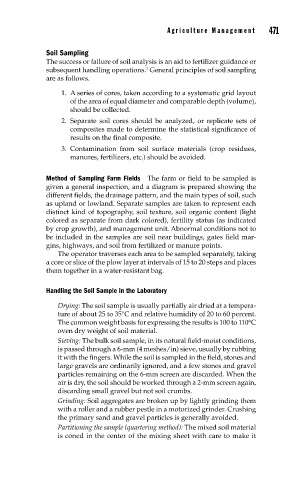Page 499 - Biosystems Engineering
P. 499
Agricultur e Management 471
Soil Sampling
The success or failure of soil analysis is an aid to fertilizer guidance or
1
subsequent handling operations. General principles of soil sampling
are as follows.
1. A series of cores, taken according to a systematic grid layout
of the area of equal diameter and comparable depth (volume),
should be collected.
2. Separate soil cores should be analyzed, or replicate sets of
composites made to determine the statistical significance of
results on the final composite.
3. Contamination from soil surface materials (crop residues,
manures, fertilizers, etc.) should be avoided.
Method of Sampling Farm Fields The farm or field to be sampled is
given a general inspection, and a diagram is prepared showing the
different fields, the drainage pattern, and the main types of soil, such
as upland or lowland. Separate samples are taken to represent each
distinct kind of topography, soil texture, soil organic content (light
colored as separate from dark colored), fertility status (as indicated
by crop growth), and management unit. Abnormal conditions not to
be included in the samples are soil near buildings, gates field mar-
gins, highways, and soil from fertilized or manure points.
The operator traverses each area to be sampled separately, taking
a core or slice of the plow layer at intervals of 15 to 20 steps and places
them together in a water-resistant bag.
Handling the Soil Sample in the Laboratory
Drying: The soil sample is usually partially air dried at a tempera-
ture of about 25 to 35°C and relative humidity of 20 to 60 percent.
The common weight basis for expressing the results is 100 to 110°C
oven dry weight of soil material.
Sieving: The bulk soil sample, in its natural fi eld-moist conditions,
is passed through a 6-mm (4 meshes/in) sieve, usually by rubbing
it with the fingers. While the soil is sampled in the field, stones and
large gravels are ordinarily ignored, and a few stones and gravel
particles remaining on the 6-mm screen are discarded. When the
air is dry, the soil should be worked through a 2-mm screen again,
discarding small gravel but not soil crumbs.
Grinding: Soil aggregates are broken up by lightly grinding them
with a roller and a rubber pestle in a motorized grinder. Crushing
the primary sand and gravel particles is generally avoided.
Partitioning the sample (quartering method): The mixed soil material
is coned in the center of the mixing sheet with care to make it

